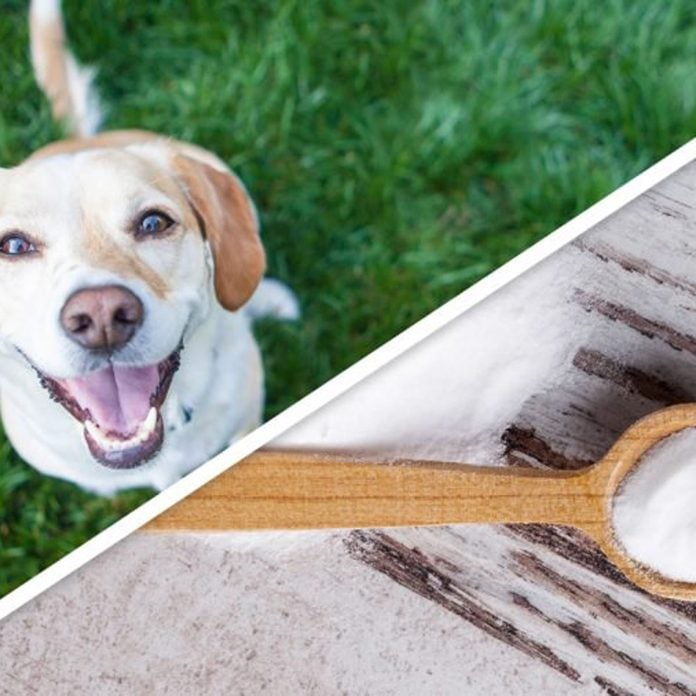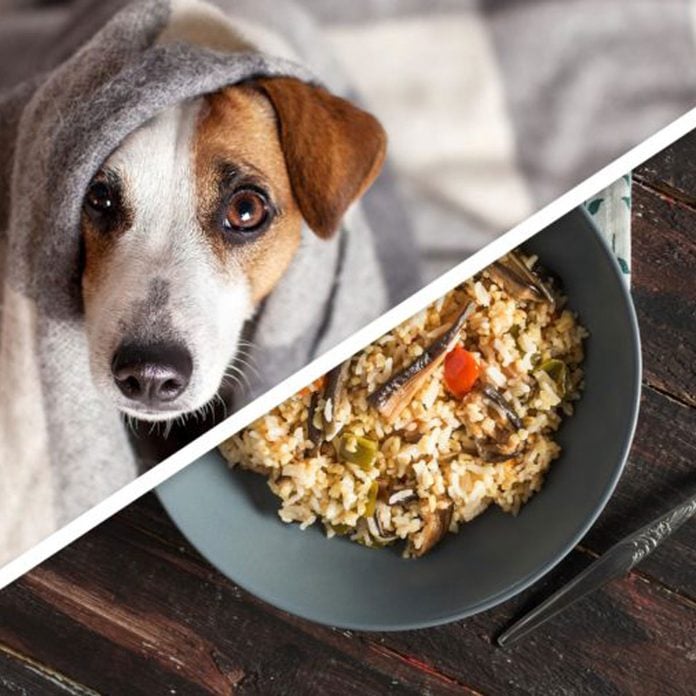
For Dogs: Brush-and-Go Dry Dog Shampoo
You can save big money by substituting a single ingredient—a one-pound box of baking soda—for a commercial dry pet shampoo. Although your pet will still need the occasional soap-and-water shampoo to remove ground-in dirt, dry shampoo will keep your dog clean and fresh-smelling during cold weather or when you’re traveling. Your first step is to test for sensitivity by rubbing a little baking soda into your dog’s coat between the ears (where it can’t be licked off). Wait for five minutes and check for reddening or other signs of irritation. If there are none, go ahead and rub the baking soda into the dog’s coat, working it in all the way to the skin. Be careful to avoid the eyes, nose, mouth, and ears. Allow the soda to remain in the coat for a full minute to absorb oil and odor. Once a minute has passed, brush the fur with a pet brush until all the baking soda and debris is removed. For more great homemade products, check out the book Homemade: 707 Products to Make Yourself to Save Money and the Earth. Plus: Check out these 40 perfect pet projects to show your pet some love.

For Dogs: Low-Fat Chicken and Rice Dog Dinner
If you want a nutritious beef-and-wheat-free diet for your pet, this combination will satisfy its appetite and may even keep its weight under control. This is also an economical dog food with fresh ingredients. Poach, bake, or microwave three pounds of chicken until well done. Cool it and cut it into cubes. Mix the cubed chicken with a cup and a half of cooked oatmeal or brown rice. Crumble in one doggie vitamin and stir it in; then fold in a pint of drained cottage cheese. Give it to your dog according to its size; feed a five-pound dog about a half pound of the mixture daily, doubling the serving for every additional five pounds. Plus, discover a better way to deal with dog hair.

For Dogs: Doggie Salad
Here’s a delicious dietary supplement for your dog. Making your own costs very little and is much fresher. To start, mix a cup of grated carrots with a third-cup of cooked brown rice. Dogs like carrots, which aid in digestion, freshen breath, and provide vitamins. In a separate bowl, mix half a cup of fat-free plain yogurt with a quarter-cup of vegetable oil. (The yogurt is digestion-friendly.) Pour this mixture over the carrots and rice and toss it all together. Serve about a quarter-cup every day, along with meals or as a treat. Check out these 14 essential cleaning tips every dog and cat owner should know.

For Dogs: Deodorizing Minty Dog Wash
When your dog rolls in something foul-smelling—as they often do—confine it outdoors and run to the bathroom supply cabinet for help. Grab a tube of toothpaste and rub the paste into the dog’s fur from head to tail. Stick with traditional-formula white toothpaste, as colored or gel pastes can discolor your dog’s fur. Allow the toothpaste to air-dry for 20 minutes. Then wet the dog and apply dog shampoo, working up a full lather. In a large bucket, combine a quarter-cup of vinegar with one gallon of warm water. Rinse the dog with this solution (double it for a big dog) and dry as usual. Feel free to repeat the treatment until the smell is gone. Plus: Our best carpet cleaning tips for pet owners.

For Dogs: Flea Powder
This inexpensive powder will leave your dog fresh-smelling, and help to repel fleas. It’s safe to apply as often as needed. Empty a one-pound box of baking soda into a mixing bowl and sprinkle with scented essential oil—rosemary, lavender, eucalyptus, or whatever scents you prefer. Stir to blend. Work the treated baking soda into your dog’s fur, beginning at the neck (where fleas congregate) and working toward the tail. Keep the powder away from the nose, mouth, eyes, and ears. Allow the powder to remain on the dog for 10 minutes, then comb or brush it out along with dirt and fleas. If you have a large dog, you may need to make two or more recipes’ worth. Check out these tips to on how to get rid of fleas for additional help.

For Dogs: Ear Mite Oil
Ear mites can lead to serious infections and problems, including hearing loss in dogs. You can help to head off problems—and expensive vet bills—with this simple treatment. Pierce a vitamin E capsule (500 IU) with a needle and squeeze the contents into a small dropper bottle. Add a quarter-cup of mineral oil and shake. Store at room temperature. To apply, hold the bottle in your hand for a few minutes to warm the oil. Put two or three drops of warm oil into the dog’s ear canal and massage gently for a count of 10. Allow the dog to shake its head, then carefully swab oil and dirt from the ear. Repeat in the other ear. Apply every other day for a full week. If you are too late and the problem persists, consult a veterinarian. It could be a yeast infection and not mites at all. Plus: We’ll show you how to easily repair pet claw marks.

For Cats: Quick Fish Stick Treats
Cats and their human companions alike will love these instant treats made from inexpensive frozen fish sticks. Empty a box of frozen fish sticks onto a cutting board. Sprinkle with half a teaspoon of garlic powder and cut the frozen sticks into one-inch squares. As a bonus, the garlic powder will help your cat repel fleas! Store the squares in a self-sealing plastic bag. To serve, remove a square and microwave it according to package directions, cool, and serve at room temperature. This recipe makes approximately 36 treats. Check out 17 amazing tips for the best pet care and safety at home.

For Cats: Melon Squares
Some cats love the flavor of melon. If yours is among them, keep some of these mixed melon treats on hand. To make them, take half an orange-fleshed melon and half a green-fleshed melon and peel and cube the melon flesh as you would for a salad. Store the melon cubes in a sealed container in the refrigerator for up to one week. Serve one or two cubes as a treat daily. Stay clutter-free at home!

For Cats: Baby-Fresh Litter
The most effective way to prevent cat litter odor is also a money-saver: Instead of throwing money away by filling the litter box to the top, just pour in a shallow layer, enough to cover the bottom of the box. Use only two to three inches so that the litter can air-dry rapidly. Sprinkle a third of a cup of baby powder over the top of the litter and stir to blend. For best results, change the litter at least once a week. Between litter changes, you can keep even the cheapest brand of litter smelling fresh with this simple, baby-safe recipe. And you’ve got to check out these luxury cat furniture pieces.

For Cats: Dry Cat Shampoo
Take the stress out of bath time for your cat by bathing it with this soothing dry shampoo. As an added bonus, you’ll save some pocket change because it’s made from common pantry staples. Combine a third of a cup of unprocessed bran, a third-cup of cornmeal, and a third-cup of rolled oats. Pour the grains into a microwave-safe plastic container, seal it, and give it a good shake. Warm it in the microwave on low for 10 seconds. When done, rub the warm grains into your pet’s fur. When finished, brush the grains out along with oil, dirt, and dander.

For Cats: Fragrant Flea Treatment
For this flea treatment, drop six drops of lavender essential oil and three teaspoons of mineral oil or baby oil into a small dropper bottle and shake to combine. Warm the oil by holding the bottle in your hands for a few minutes. Before you apply, keep in mind that cats can be sensitive to any flea treatment, particularly toxic commercial flea powders. So first, try this mixture on a small patch of skin on the cat’s stomach and wait for a day to see if there is a reaction. If not, go ahead and massage the warm oil into the neck area and base of the tail where fleas congregate, then all parts of the cat, being careful to avoid contact with the eyes, ears, nose, and mouth. Repeat treatment when the scent is no longer detectable. You must also wash the cat’s bedding and vacuum the house thoroughly to get rid of flea eggs. Plus: Learn how to fix lawn spots in your yard.

For Birds: Finch and Canary Treats
Here’s a bite-sized nutritious treat that’s easy to make for small songbirds, such as finches and canaries. It’s fresher and far less expensive than store-bought treats. In a medium bowl, mix a quarter-cup of crunchy, unsweetened peanut butter with a half-cup of high-quality finch seed mix. Add more seeds if needed to make a stiff batter. Pour a quarter-cup of wheat germ into a shallow saucer. Form the peanut butter mix into small balls and roll the balls in the wheat germ to coat. Serve one ball as a treat in a bird-proof bowl. Store the leftovers in a covered container in the refrigerator for up to one month or freeze for up to three months. The mixture should make about eight treats. If you like watching birds during winter, then you’ll want to know these tips on how to attract birds in winter.

For Guinea Pigs: Guinea Pig Salad
Fresh vegetables and fruits should be essential parts of a guinea pig’s diet. The dried treats sold in pet stores are good in a pinch, but they’re expensive and a poor substitute for fresh treats. This is a vitamin-rich fresh salad that’s easy to make and good enough to share with your guinea pig. In a bowl, toss a half-cup of chopped fresh spinach, a quarter-cup of grated carrot, and a half-cup of chopped strawberries. Add a quarter-cup of orange juice and toss. Serve in a feeding bowl. Remove and discard uneaten salad after four hours. Store leftovers in a sealed container in the refrigerator.

For Hamsters: Hamster Fruit Cup
Experts agree that dried hamster pellets and treats do not provide a complete diet and pet stores don’t include a salad bar, but your hamster can scurry to its bowl for this budget-friendly sweet treat that you can whip up in no time using fresh fruits and vegetables. Slice up half a banana and toss with a quarter-cup of grated carrot in a bowl. Add a sprinkling of lemon juice to keep them from discoloring. Drain the juice from the bowl; add three teaspoons of raisins and a teaspoon of honey and mash with a fork. Serve half in a treat bowl and store the remainder in a covered container in the refrigerator. Remove and discard uneaten treats after four hours.

For Gerbils/Rabbits: Gerbil and Rabbit Salad
It’s important to offer pet rodents vitamin-rich fresh fruits and vegetables, and your gerbils and bunnies will welcome this healthy salad. Toss a quarter-cup of finely chopped spinach or leaf lettuce with a quarter-cup of grated carrot. For budget-boosting ingredients, ask for discarded outer leaves (which are more vitamin-rich than inner leaves) at your produce counter, farmers’ market, or a restaurant salad bar. Top with a teaspoon of sunflower or pumpkin seeds (for variety, alternate seed toppings) and serve in a small treat bowl. Store leftovers in a sealed container in the refrigerator for one day. Remove and dispose of uneaten fresh foods after four hours. Plus: Here are 10 high-tech gadgets you and your pet will love!